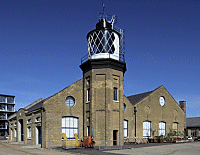|
An isolated pair of peninsulas, formed by the meanderings of the River Lea (here called Bow Creek) as it reaches the Thames.
Although there are records of ships being unloaded here as early as 1297, there was little human activity besides some farming
and fishing until the late sixteenth century, when a house was built, with an orchard and a moat. A second incarnation of
the house became a pub early in the eighteenth century. The creation of the East India Dock in 1806 made road access to Leamouth even more difficult but encouraged industrial development and the building of homes
for workers. The northern peninsula, known as Goodluck Hope, became a centre for glass-making and then for galvanised iron
manufacture, which continued until the 1960s. The close-knit (and allegedly inbred) residential population was extinguished
by a slum clearance programme in the 1930s. Until recently a vegetable oil refinery covered nearly all of Goodluck Hope. The
site is presently (mid-2008) the subject of major redevelopment proposals, including a new bridge to Canning Town (probably
for pedestrians and cyclists only), but the scheme has been stuck at the planning stage for some while. Leamouth’s most
enduring employer was the Corporation of Trinity House, which occupied the tip of the eastern peninsula from 1803 to 1988.
Trinity Buoy Wharf is now a centre for arts and community projects while the restored chainstore, complete with lighthouse
(see image below), hosts leisure events.
 |

